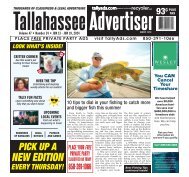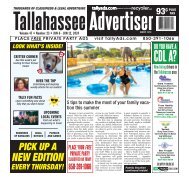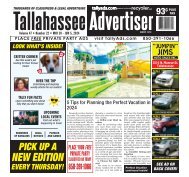Truckload Authority - Winter 2014/15
You also want an ePaper? Increase the reach of your titles
YUMPU automatically turns print PDFs into web optimized ePapers that Google loves.
Dallas after winning the Yukon Quest, 2011<br />
Leaving the Unalakleet checkpoint<br />
during the 2012 Iditarod<br />
Dallas and Beatle<br />
“Selfreezie!”<br />
Jim Keller, Dallas, Rosanne Keller<br />
Dallas and his wife Jen<br />
Dallas with lead dogs, Beatle and Diesel<br />
there, but it meant a lot of things had to go right. And<br />
we’re very fortunate that we achieved that goal.<br />
“This year, we’ve had the best team we’ve ever had<br />
and next year will be even better than this. And as more<br />
and more young dogs that have gone through our programs<br />
join the racing team, our team becomes stronger<br />
and stronger every year. Having that sponsorship first of<br />
all is what allowed me to get into mushing as a career,<br />
and without the Kellers, I probably still wouldn’t be at<br />
this point; I’d still be trying to figure out a business plan<br />
that would allow me to start racing when I was 30 or 35,<br />
which is more common. There’s no replacement for having<br />
a sponsor like the Kellers and<br />
it’s just a phenomenal place where<br />
you have to do things and have to<br />
change things that’s not best for the<br />
team for want of money but we’ve<br />
been able to bridge that gap every<br />
time with the Kellers.”<br />
Seavey’s relationship with the<br />
Kellers led to the autobiography,<br />
“Born to Mush.” The book is<br />
available through amazon.com or<br />
by going to Iditarod.jjkeller.com.<br />
With the stage now set, let’s return to the<br />
fateful March day in the year of our Lord <strong>2014</strong>,<br />
and conclude the tale that will live in Iditarod<br />
lore forever. This wise, confident, passionate,<br />
patient and freezing young Iditarod racer<br />
decides it’s time to leave White Mountain and trek the<br />
final 76 miles and claim his third-place trophy.<br />
After all, he knows King has reached White Mountain<br />
first and a vast majority of the time the musher who<br />
gets to White Mountain first wins the race.<br />
At the time, King was about one hour ahead of<br />
Zirkle, who was two hours ahead of Seavey.<br />
“I felt we had accomplished our goal of traveling this<br />
trail as fast as my team was capable of,” Seavey recalls.<br />
“And they were all happy and strong. We were going to<br />
push to the finish line whether we caught either of the<br />
other two teams. We race on principle, so it doesn’t matter<br />
if Aliy is two hours ahead of us we’re still going to run our<br />
race and get to the finish line as quickly as possible.”<br />
So off they went, the young musher and his team.But<br />
they quickly found themselves in danger. Within about 30<br />
miles of leaving White Mountain, going over the hills before<br />
they reached the coast near Nome, the wind started<br />
picking up very strongly, blowing them off the trail. Seavey<br />
adjusted the instruments on his sled and focused on getting<br />
the team to the finish line. He knew this terrain well,<br />
and knew the mountains there formed a tunnel through<br />
which the wind whipped almost ceaselessly.<br />
“Our goal now, realizing this run was going to be<br />
harder than we anticipated, was to ration our energy<br />
to make sure we could reach the finish line in one shot<br />
without stopping, taking a break or stopping to refuel,”<br />
Seavey said.<br />
By the time they got about 40 miles into the final<br />
push, the wind became an “absolute hurricane.”<br />
“We’re trying to get to the finish line, but more importantly,<br />
we’re just trying to survive,” Seavey recalled<br />
recently as though it had happened only yesterday. “On<br />
the left side, we have about a quarter mile of glare from<br />
sea ice and then open black water into the Bering Sea.<br />
On the right side we have a little icy view, a little driftwood<br />
and the wind coming from a couple of mountains, gusting<br />
up to 60 miles an hour coming from the north, which<br />
is on our right trying to blow us out into that open water.”<br />
His dogs have no traction; there is the glare and<br />
the driftwood. The conditions are only worsening by the<br />
second.<br />
“Every time the wind gusted, the dogs would pretty

















